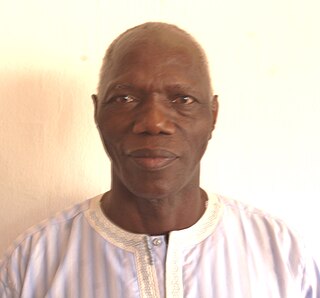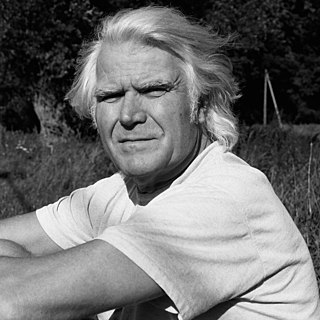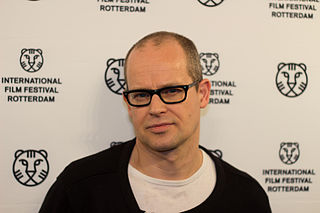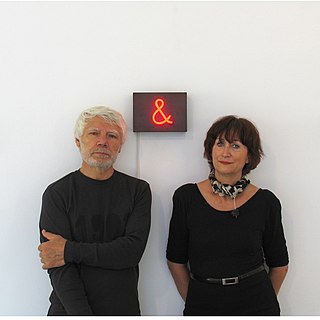
Adolph Stephan Friedrich Jentsch was a German-born Namibian artist. He studied at the Dresden Staatsakademie für Bildende Künste for six years, and used a travel grant award to visit France, Italy, UK and the Netherlands. Jentsch moved to Namibia in 1938 to escape the approaching war and lived there until his death. He travelled extensively in Namibia and eventually settled down near Dordabis, about 60 km from the capital Windhoek. He is one of Namibia's most famous painters.

Abdoulaye Konaté is a Malian artist. He was born in Diré and lives and works in Bamako.

Clemens Weiss is a German artist living in the United States.

Abraham David Christian is a German sculptor.
Norbert Müller-Everling is a contemporary German artist working with concrete art.
Contemporary African art is commonly understood to be art made by artists in Africa and the African diaspora in the post-independence era. However, there are about as many understandings of contemporary African art as there are curators, scholars and artists working in that field. All three terms of this "wide-reaching non-category [sic]" are problematic in themselves: What exactly is "contemporary", what makes art "African", and when are we talking about art and not any other kind of creative expression?
Jems Robert Koko Bi is an Ivorian sculptor.

Ivo Ringe is a German artist, who is classified as a concrete art painter. He is also a docent and a curator of international group exhibitions.

Erik Gerardus Franciscus van Lieshout is a Dutch contemporary artist most widely known for his installations. In 2018, he won the Heineken Prize for Art.

Asta Gröting is a contemporary artist. She works in a variety of media like sculpture, performance, and video. In her work, Gröting “is conceptually and emotionally asking questions of the social body by taking something away from it and allowing this absence to do the talking.”

The Museum der Völker in the Austrian Schwaz in the county of Tyrol was founded in 1995 as a cultural association Haus der Völker by Gert Chesi and belongs to the well known Ethnology museums in Europe. After a new construction and remodeling the exhibition operation opened on the 12th of April 2013 as Museum der Völker. Translated the name means museum of the peoples or museum of the tribes.

Gert Chesi is an Austrian photographer, author, journalist and filmmaker. At the end of the 1970s he became internationally famous after publishing the book Last Africans, which was translated into six languages. In 1995 Gert Chesi founded the Haus der Völker in Schwaz, which is a museum for tribal art and ethnography.
Kathrin Sonntag is a visual artist who works in photography, sculpture, film, and installations. Her work has been exhibited in museums including the Kunstverein in Hamburg, Germany and the Solomon R. Guggenheim Museum in New York City.

The Akodessawa Fetish Market is located at Akodessawa, which is a district of Lomé, the capital of Togo in West Africa. The Akodessawa Fetish Market is the world's largest voodoo market.

Aatifi is a contemporary Afghan-German painter, printmaker and calligrapher. He was born in Kandahar, Afghanistan. He lives and works in Bielefeld, Germany. His works contain abstracted Arabian calligraphy and modern European influences.

Molitor & Kuzmin are a collaborative duo of visual artists, who are classified as light art and installation artists.

Arvid Boecker in Wuppertal) is a German painter and curator. He is a representative of concrete art and focuses on color field painting.
Ulrich Erben is a German painter. From 1980 to 2005, he was a Professor of Painting at the Kunstakademie Münster. He is known as a master of the color field style of abstract painting, closely related to abstract expressionism, in which he creates tension between a defined surface structure, his own method of applying paint to a canvas, and the relationship of various shades of white or color to each other in their placement as part of a composition on the flat plane of a canvas. In 1986 and 2008, he was awarded the Konrad-von-Soest Prize for Visual Arts by the Landschaftsverband Westfalen-Lippe.
Christoph Girardet is a German filmmaker and artist. He lives and works in Hanover.

Lefifi Tladi is a South African painter, poet, sculptor and musician. As a member of the black consciousness movement he was exiled from South Africa in 1976. He lived in exile, primarily in Stockholm, Sweden, until the abolition of apartheid, and in 1997 returned to South Africa for the first time in over 20 years. In 2021, he was awarded the lifetime achievement award by the South African Literary Awards.



















